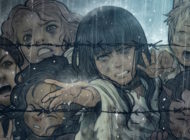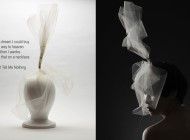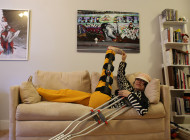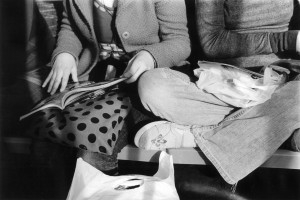I suppose you think it extraordinary. But really in this region, it is nothing unusual. In fact, this city grew up because of this trade. Back in the day, all the work was done by hand, and much more was done. All the famous manufacturers from Lyon used to send their cloth here for the finest work, before it was sent elsewhere to be sold.
All of the women in my family were involved, back to when the work began. It was much better than the work outdoors. The children could learn from an early age, and it’s how I learnt to sew. My aunt would scold me for leaving droplets of blood on the manufacturer’s logo. I hated wearing a thimble, my fingers would feel like they couldn’t breathe.
That’s mainly what we do these days—T-shirts, logos—famous, expensive brands. They choose to afford us to sell their cotton at a higher price, and the money for us isn’t bad either. It’s all been computerised of course, very unromantic. Much less blood, far fewer tears.
And I always laugh when I see one of those elegant types, wearing one of those expensive shirts. It’s strange isn’t it, when you work on something? It’s worth more to you in one way, and then, at the same time, you know it’s not worth a jot! It is because you’ve had your fingers on it, it changes the worth of things.
My aunt was the one that made me aware of this. It was unfortunate really that she ended up sewing, her talents were far greater than that. But this is a conservative country, and my grandparents only had enough money for one child to be sent to university. And so she stayed at home, and my father went.
By some crazy stroke of luck, he ended up studying art. He was technically very good, but not very imaginative. He loved these mountains, and being away at university made him romantic. He began to paint them as landscapes. This won him a job painting decorative chocolate boxes for local chocolatiers. He started to do so well that he left his studies. Soon his designs were being more widely noticed, and he started going for interviews at the large chocolate houses. And so it turned out he was a good business man. He knew what sold, and genuinely this was the style he liked to paint. I know it must seem unbelievable, but really what is the point in having a sophisticated artistic sense if you can live life so well?
He started to have some influential friends, and they of course became close friends of the family. My aunt got to know a few of them, but she herself was more old fashioned, and always a little suspicious of outsiders. They, of course, thought she was charming.
For some time now these friends had been talking about a particularly large project: A commission for a piece of work which would hang in the most famous chocolate family’s most important meeting room.
It would be unveiled at a special ceremony, celebrating 150 years of the finest chocolate. Nothing had been said, but it was widely assumed that my father would be the painter awarded the job. He had thought about it with a special pleasure; it would be the reward and recognition for what was becoming a long and distinguished career.
On one of the familial visits, however, his most influential friend took a tour around my aunt’s embroidery studio, or factory as she like to call it. In those days she still worked by hand, and a lot of it was very fine indeed. He was deeply impressed. Even though she had never gone to university, she matched my father’s technical ability and surpassed his imagination. Where my father always took the safest route up the mountain, she always approached the cloth with a sense of risk, and you were never completely certain she would finish and succeed. Although, of course she always did.
My father’s friend immediately saw the potential and his own opportunity. This was exactly what they were looking for: a medium completely expressive of their country, the perfect celebration of chocolate and family.
After swift communications with the company, my aunt was enthusiastically given the commission—an embroidered portrait of the mountains. Despite her brother’s crestfallen expression she took it happily. After all, what else could she do? It was better the money stayed in the family.
Her work was always brilliant, and this piece was no different. In fact, perhaps it was different, in that it was so good, you could really call it a masterpiece. My father tried to be happy for her, but every night he went to bed in a bad temper, taking it out on my mother. He was genuinely a kind person, but kind people can also suffer terribly. He began to question himself, even his decision to leave art school to make money. It made him feel weak, and empty, and he felt sick with shame.
One night he was invited to the studio of an old art school friend who had moved back to the mountains to make abstract interpretations. This friend enjoyed the cliché of the artist’s life and drank the local eau de vie enthusiastically. Needless to say, he succeeded in getting my father extremely drunk, and the two of them became hyperactive and silly.
In this state, they wandered like elephants down the street and into our house, making a racket on the stairs and waking everyone up. This had been partly expected, so we did our best to ignore and go back to sleep. My aunt, however, could hear them approaching her factory. She lay in her bed and listened to them giggling and knocking things. And then she heard a kind of silence, which made her worry.
Getting out of bed she walked along the hall to see what they were doing. At first, on opening the door, all she saw was my father’s friend snoring asleep. This made her laugh and she looked up to see what her brother was doing. There he was: swaying on his feet, and painting thick daubs onto her screen. On seeing her he merely smiled and collapsed into the chair, drunk asleep.
There were no witnesses to the destruction of the screen, but that night my aunt unpicked every last thread. In the morning she was silent, and she went to bed and slept. A few days later, my father won the commission. And he made a very good, very depressed painting.
And, of course, he never got over it. Although my aunt showed no further signs of suffering. When once I asked her about it she simply said,
‘Oh my dear, there is no story…My brother was the artist. I? I just sew thread’.
—
By Buffy
Image of “La Dame et la Licorne”/ “the Lady and the Unicorn
Tags: art loss
























0 Comment